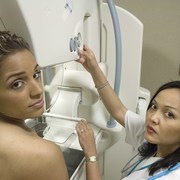There are few things more frightening to a woman than finding a lump in her breast. Breast cysts may feel like lumps, but they rarely contain tumors.
A tumor is a solid mass of cells that occurs when something causes the cells to grow out of control. In contrast, a cyst is a fluid-filled sac. Breast cysts appear when fluid accumulates in pockets in the breast. This can happen when a milk duct get blocked by an overgrowth of connective tissue. Breast cysts are often described as round or oval lumps with distinct edges. These cysts can vary from the size of a pea to the size of a ping pong ball. They may have the consistency of a water-filled balloon or soft grape, or may feel more solid.
Breast cysts are most common in women from age of 30 to 40, but they are also found in women into their 60s. They tend to follow a woman’s monthly cycle and may feel larger and cause tenderness or pain in the breast just before your period. Breast cysts typically go away following menopause.
Cysts in the breast may be too small to be felt or located by a physical exam such as a monthly breast check. When a cyst appears on a mammogram, an ultrasound of the breast is usually scheduled. This test will enable the doctor to see if the cyst is filled with fluid or if it is a solid lump which could be a tumor.
Almost all breast cysts are simple cysts which are benign (not life-threatening). These cysts rarely if ever turn into cancer. Approximately one breast cyst out of every 1,000 contains a tumor. Even in these cases, the cysts are rarely cancerous. Overall, women with breast cysts are at no higher risk for developing breast cancer than any other women. This risk may be slightly higher if your mother, sister, or daughter has been diagnosed with breast cancer.
Only your doctor can determine whether a lump in your breast is a cyst or something more serious. If you find a lump in your breast, have it evaluated by your health care professional.
Further reading: Procedures to Take Care of Breast Cysts
Sources:
Mayo Clinic
California Pacific Medical Center
National Institutes of Health: Medline Plus
American Congress of Obstetricians and Gynecologiststs






Add a CommentComments
There are no comments yet. Be the first one and get the conversation started!